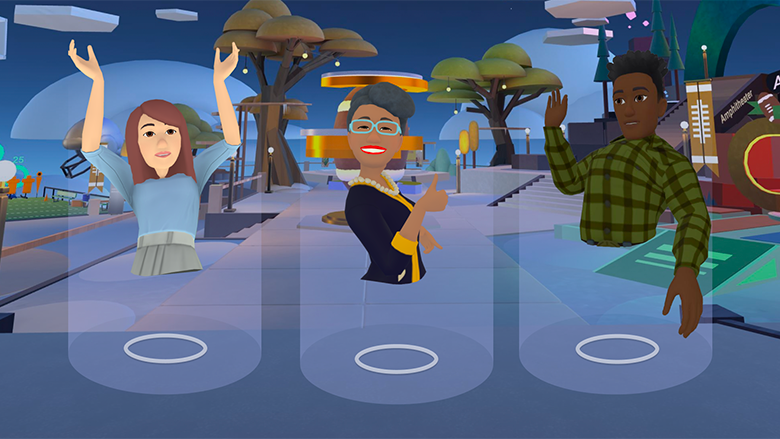Welcome to part eleven in our blog series that takes a look at some of the top trends across the XR industry and examines where and how Augmented, Virtual and Mixed Reality (AR/VR/MR) technology is currently being utilized. In this post we will be exploring the topics of privacy, safety and security in XR and the metaverse.
In the novel ‘Ready Player One’ (adapted into a film in 2018), author Ernest Cline names the virtual world the ‘OASIS’ – a VR haven for users to access in order to escape the decline of the real world in which they inhabit. In order to create a safe haven for users within whatever form of OASIS is created in this reality that we all inhabit, whether in the form of the Metaverse (a term also coined from a novel), or something else, it will be important to take into account things such as user safety and security of data.
For worldwide adoption of something like the Metaverse, users are not going to want to sign up if they feel that their data is at risk. Due to the nature of XR technology and the inputs required in order to fully take advantage of some of the experiences available, it means that there is a lot of data being processed and many users may be unaware at just how much private information they might be handing over to corporations, simply by using their devices.
Types of data collected can include:
- Standard personal information required for account setup (name/age/DoB/etc);
- Speech data and voice recognition;
- Eye tracking data that measures user interest (by measuring pupil dilation when a user is focusing on a specific area of the screen whilst in VR)
- Biometric data such as user height (used to properly calibrate a VR experience), and in some cases retina / iris scanning or recognition for sign in.
- Room tracking data that captures a user’s entire surroundings, often in a personal environment such as a family space or bedroom;
- Geographic and location data for AR devices, and much more.
In some cases, VR devices can be equipped with BCIs (Brain Computer Interfaces), which allow the wearer to control a device simply with their thoughts. However, in order for this to be achieved, a device has to first be able to read brain activity and interpret this information in order to carry out an action. Essentially, the technology is able to “read your mind”, so to speak. In fact, AR device companies are actively acquiring BCI technology companies in order to be able to implement this technology in their future generations of devices. For example, Snap recently acquired neurotech company NextMind earlier this year. The concern here though, is that if companies are able to offer AR glasses that you control with your thoughts, then the user thought data then has to be processed and likely stored somewhere too. With cybercrime and data breaches a real risk in today’s world, there is no guarantee that literally the very thoughts you think would be safe from cyber attack or theft.
Another theme in Ready Player One that may ring true with the world we live in at the moment is that of multinational corporations attempting to control the OASIS in order to monetize it. This is something that many users fear, particularly if our digital identity is going to exist entirely on or within the Metaverse. There are genuine concerns that any one single organization with a controlling share of the Metaverse would be able to utilize user data in ways that users may not necessarily consent to. Controlling how companies will use data is something that will need to be carefully managed and monitored through policies and oversight organizations.
Thankfully, there are organizations that are actively working to avoid any potential dystopian XR futures. One such organization is the XR Safety Initiative (XRSI), which is a worldwide not-for-profit organization that promotes privacy, security, and ethics in the immersive environments (AR, VR and MR). The organization’s mission is to help build safe and inclusive experiences so that XR stakeholders are able to make informed choices and decisions. Through its mission, XRSI has positioned itself in such a way that it is able to provide impartial, practical information about XR related risks and opportunities to individuals, corporations, universities, government agencies, and other organizations worldwide.
 An illustration of Meta's Personal Boundary feature (not actually visible whilst in-app though).
An illustration of Meta's Personal Boundary feature (not actually visible whilst in-app though).
Companies like Meta who are getting in early in an effort to lay the foundations of how the Metaverse will function have already made efforts to accommodate things like user safety. For instance, Meta introduced features to its Horizon Worlds platform such as a ‘Personal Boundary’. Users can choose to activate the personal boundary, which will put roughly 4-foot of distance between their avatar and others.
Things such as Horizon Worlds’ Personal Boundary feature have come about due to community requests, partly as a result of poor behavior by some users, whether by way of invading the personal space of other users, harassment, or general negative interactions between users. Determining a set of behavioral guidelines will therefore be important to the growth of XR’s usage, whether it is in the Metaverse, or out and about in real life whilst wearing AR wearables for example. Essentially, just as the real world is governed by laws and regulations, so too should the virtual world be governed.
Many companies have their own policies and guidelines that users have to abide by in order to use their platforms, however, conformity of these guidelines will certainly help to increase understanding amongst users as to how to behave and conduct themselves in virtual or augmented spaces.
As well as regulating the Metaverse, it is equally as important to ensure that from the beginning, any form of Metaverse is built to be a safe online space, using a human-centric approach, and with inclusivity at its core. Organizations and communities such as GatherVerse are already working to bring people together to discuss “humanity first standards of education, safety, privacy, wellness, equality, community development and accessibility in the next steps of the Metaverse.”
At AWE USA 2022 we will be featuring our “XR Safety & Security” agenda track, which will explore the topics of privacy, safety and security in XR and the metaverse, with a focus on some of the steps users can take to protect themselves and how companies are protecting their users. Some of the best talks from the track will include:
- It Takes a Village to Build the Metaverse
- Regulating the Metaverse
- Preparedness for Safety in the Metaverse
- Inclusivity in the Metaverse
- Digital Rights to Neuro Rights - Security, Safety & Metaverse Citizens Rights
Don’t miss the world’s leading AR/VR conference, taking place June 1-3 in Santa Clara, California.



